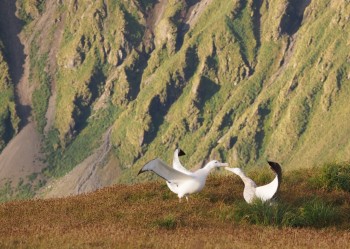Australia’s Macquarie Island is recovering from the ravages of now-removed introduced mammals, allowing its seabirds to breed without predation by cats and rats and habitat alteration by rabbits (click here).
News of research on Macquarie’s small population of ACAP-listed and Vulnerable Wandering Albatrosses Diomedea exulans was reported in the island’s electronic newsletter “This week at Macquarie Island” last month by ornithological researcher currently based on the island, Kate Lawrence (click here). It is repeated here with permission as it gives a good account of what it is like to work on a sub-Antarctic island – both in the field with the birds and at the computer in the lab.

A Male Wandering Albatross on its nest at Petrel Peak prior to egg-laying

A Wanderer pair on their nest (female in front) below Mount Haswell
“On Saturday I returned from a great 12 days in the field 'wanderer' watching. My purpose was to check on the seven wandering albatross nests we have here this season, to identify partners that we had not yet seen on four of the nests, and to identify any non-breeders hanging about. So armed with my binoculars, profile pictures of birds we had already identified and my notebook, I set off for Waterfall Bay on day one, to get ahead of the Macquarie Island Pest Eradication Project (MIPEP) crowd also heading down island on the same day.
When we identify a wanderer by reading the number on the band around its leg, we take a profile picture for future reference. The plumage on the birds is varied and unique, so having the pictures of the breeding birds previously seen meant that I could identify if that same bird was on the nest from a distance, and prevent unnecessary disturbance. When we do need to go close to a nest or a non-breeding bird, we sneak up very carefully and slowly, staying quiet and out of sight until close. As soon as we’ve snuck a peek at the bird’s band and snapped a quick pic, we retreat back out of sight.

Courting Wandering Albatrosses at Petrel Peak
On day two I headed cross country to Cape Star to check if the female of the pair had returned to incubate – luckily she was there. Then it was on to the Amphitheatre to check the status of two nests there. As we already had identification for both partners on those nests, I made a quick check to see if the adults were still happily incubating. It was then down to Caroline Cove hut for the night.
The following day on Petrel Peak two more of the birds I needed to identify were on their nests so I was feeling super productive – just one previously unseen bird to go! The first incubation shift on the nest taken by the male can be up to 21 days, so I spent the next week checking on the nests and hoping the last remaining bird would turn up, but to no avail. Hopefully we will see her on our next visit! Luckily my time was not wasted; I also obtained some re-sights of non-breeding birds on Petrel Peak, in the Amphitheatre and on Cape Star, including a courting couple on the top of Petrel Peak.

A wanderer flies over the Amphitheatre
Upon my return to station, I plugged some band numbers into our database. Here are some interesting facts about some of our breeding birds this year:
The male incubating on the nest on Petrel Peak is a 25-year-old bird. In the years between 1998 and 2004 he bred successfully four times with the same partner (wanderers are biennial breeders - every other year). Then she seems to have disappeared – she has not been seen since 2005. Sadly, this could be due to being caught on a long-line hook. Of course we can’t know for sure but long-line fisheries are one of the major threats to a number of species of albatross, including wanderers. The females from Macquarie Island are more vulnerable to this threat than the males because they head north to feed and are more likely to encounter fisheries than the males who head south.
If a partner dies, it can take years for the bereaved bird to find a new partner (especially given the shortage of females, but also because they can be very picky about choosing a mate!) In this case, our male took five years to find a new partner, and bred successfully with her in 2009/10 and 2011/12. This is the nest where we have not identified the female this season, but we expect it to be the same female as in 2009/10 and 2011/12.
The nest at the base of Mt. Haswell has an 18-year-old male and female of unknown age (as she was not banded as a chick but as an adult in 2006). From 2007 to 2010, the male built 'sits' (a sit is a pile of nest material generally smaller and less well-formed than a nest, that gets built up into a nest if a breeding attempt is made), courted and tried to call in females. However, it wasn’t until 2011/12 that he got hitched and bred successfully with the same female as this year. In 2006/07 and 2008/09 the female bred with a different partner, unsuccessfully the first time and successfully the second. Three years later she’d switched to her current partner.
Let’s hope that this year, the second breeding year for this partnership, is also successful!”
With thanks to Kate Lawrence for permission to reproduce her account and her photographs.
John Cooper, ACAP Information Officer, 30 March 2014

 English
English  Français
Français  Español
Español